All You Need to Know About Switching To 1500 V DC System Voltages in Solar Power Plants
The growing demand for renewables and increase in efficiency & scale of production has made the industry a lot more competitive over the years. It has become essential to optimize all units of a solar power plant. Therefore, the solar industry has invested a lot in the field of solar research, which can help to improve the solar system’s performance.
Navitas Solar, a Surat-based solar module manufacturing company, working on a national scale, pays utmost attention to optimising all the units of a solar plant, be it for a household or a large commercial establishment.
When it comes to optimization of any product/service/technology/ process, it simply means to enhance the efficiency and reduce the cost. One of the factors affecting the solar system’s performance is the voltage of a solar plant.
Earlier, the 600 V solar system was used. A clear shift was noticed from 600 V to 1,000 V systems until 2012. The shift was beneficial, as it reduced installation costs and at the same time, increased profitability by reducing the number of inverters. The transition from 600 to 1000 V took place in Europe before the US. Therefore, most of the required shift change in the BoS (Balance of System) was available in the market when the US opted for 1000 V from 600 V. Still, the change in the BoS was not to a major extent when the industry shifted from 600 to 1000 V. Then a shift from 1000 V to 1500 V took place.
The idea behind the voltage increase remained the same – increased profitability and reduced number of BoS components. The difference in the shift of 600 V to 1000 V and 1000 V to 1500 V was that while going from 1000 to 1500 V, the shift was taking place globally unlike the previous shift. In addition, the major installations were not occurring in the US and Europe, but they were occurring in India and China majorly.
The transition from 1000 V to 1500 V was a more cautious process than the previous one as by then the awareness and know-how of the technology were much more and it was not a simple black box for everyone. Considering the modernization of equipment, this transition was considered natural and logical.
Now, let us understand the advantages and disadvantages of going for 1500 V.
Driving force behind the shift from 1000 V to 1500 V:
- While going for 1500 V from 1000 V, as the voltage is increased, the current flowing through the cable is decreased for the same power requirement. As the current is decreased, power losses (measured as I2R) also decrease. When ohmic losses are decreased, power generation is increased and end-to-end efficiency is improved.
- When a mean voltage rating of a typical solar module is considered around 36-37 V, then 18-22 modules will be connected in series to form a string of 1000 V. Whereas, while going for a 1500 V system, 28-32 modules can be connected in series to form a string of 1500 V.
Advantages of the transition from 1000 V to 1500 V:
- When a larger number of panels are connected in series, the capital cost in equipment and installations is reduced in mounting structures, DC combiner boxes and array cables.
- Decreased array cable length furthermore reduces cable losses that are directly proportional to the cable length.
- 1500 V array voltages mean fewer strings, connections and terminations, reduced cabling, lower system losses, decreased inverter cost for a given capacity and increased energy throughput.
- Less wiring and trenching are required in 1500 V systems and less labour as well which helps in capital cost saving.
- A solar power plant keeping constant power output, making this change to less string for 1500 V can lower costs by ₹0.75 per watt.
Disadvantages of the shift from 1000 V to 1500 V:
- Higher system voltage accelerates the potential induced degradation (PID) losses of solar modules. It is observed that PID is mainly affected by the system voltage. Nevertheless, with the commercial availability of PID resistant raw material, PID losses can be mitigated in the long term.
- Higher O&M costs: generally, higher voltages put more electrical stress on the equipment and therefore they require preventive maintenance, which sometimes increases the cost.
There is a possibility of 2000 V entering the market considering the cost optimization. However, for low voltage applications, 1500 V is the IEC limit. Voltages higher than 1500 V are considered high voltage. Therefore, new standards will be required for high voltage components. In addition, component development to meet onsite safety requirements may also become a challenge. It is still in the R&D stage, and it will take a few years to make a standard. Till then, 1500 V systems will continue to be the best technology for utility solar systems.
If you find these details too technical and overwhelming, just don’t panic! Navitas Solar is with you all at the steps of optimizing your solar power system and helping you get the most out of it.


 Online | Privacy policy
Online | Privacy policy
Related Posts
You May Also Like
Bonito Series: Driving Innovation in…
Read MoreTOPCon Series: The Next Generation…
Read MoreValuable Points to Remember During…
Read MoreNavitas Planet Partners with Hysolwin…
Read MoreDriving Towards a Sustainable Future:…
Read MoreWhy Do Top-Grade EVA Sheets…
Read MoreBonito Series: Driving Innovation in…
Read MoreTOPCon Series: The Next Generation…
Read MoreValuable Points to Remember During…
Read MoreNavitas Planet Partners with Hysolwin…
Read MoreDriving Towards a Sustainable Future:…
Read MoreWhy Do Top-Grade EVA Sheets…
Read MoreBonito Series: Driving Innovation in…
Read MoreTOPCon Series: The Next Generation…
Read MoreValuable Points to Remember During…
Read MoreNavitas Planet Partners with Hysolwin…
Read More